This article lists bugs which you and I have encountered in macOS Mojave 10.14.3 itself, rather than issues in specific third-party applications and other software. Note: This article refers to 10.14.3 and is no longer being maintained. To see the list of bugs in 10.14.6, which is being maintained, please go to this article.
Finder Aliases – Finder hangs when trying to open/preview a broken folder alias
In a Column view, if you try to open or even just preview a Finder Alias to a folder which now no longer exists, the Finder hangs with a spinning beachball. The only way ahead is to press Command-Option-Escape and force the Finder to restart.
Trying this with an orphaned Finder Alias to a file, rather than a folder, doesn’t cause the Finder to hang, but to display the normal dialog offering to delete or fix the alias, as it should.
This bug also affects Bookmark-based aliases created by alisma, and is discussed in full detail here. It has been reported to Apple, but remains unfixed.
System Information – Legacy Software misleading
The information given about ‘legacy software’ in System Information is incomplete and misleading. Fuller details are here. Use 32-bitCheck (from Downloads above) instead.
macOS seems to be building this list as and when macOS warns the user that each specific 32-bit app needs to be replaced. Those warnings now occur more frequently, but are still far from complete or comprehensive. Until their list is complete, which could be well into 2019, users will find 32-bitCheck far more reliable for informing them which apps and other software are 32-bit.
Privacy protection – free access to ~/Library/Safari
Jeff Johnson, developer of StopTheMadness and Underpass, has discovered a means by which apps with a hardened runtime enabled, in other words any notarized app, can access the protected folder ~/Library/Safari without any restrictions being applied by Mojave’s privacy protection. He has disclosed this to Apple, but has not provided further public information. This is effective in all versions of Mojave, including 10.14.3 with the Supplemental Update installed.
This apparently only applies to hardened apps; those which run in a sandbox, as do all supplied from the App Store, cannot exploit this vulnerability.
Network Directory Service – macOS hangs for seven minutes
According to Marcel Bresink, if an app asks macOS Mojave for a complete list of group accounts on a system which uses a network directory service, this can hang macOS for a period of seven (yes, 7) minutes. He has had to work around this problem in his TinkerTool app version 6.2.
I confess to not having tested this out here, but rely on his account in his release notes.
(Thanks to Barry Marshall for drawing my attention to this.)
Disk Utility – can’t resize APFS disk images
This bug appears to have been present since the release of APFS in High Sierra, and persists in 10.14.3. Using the Resize… command in the Images menu on a disk image in APFS format invariably fails immediately, with an error message.
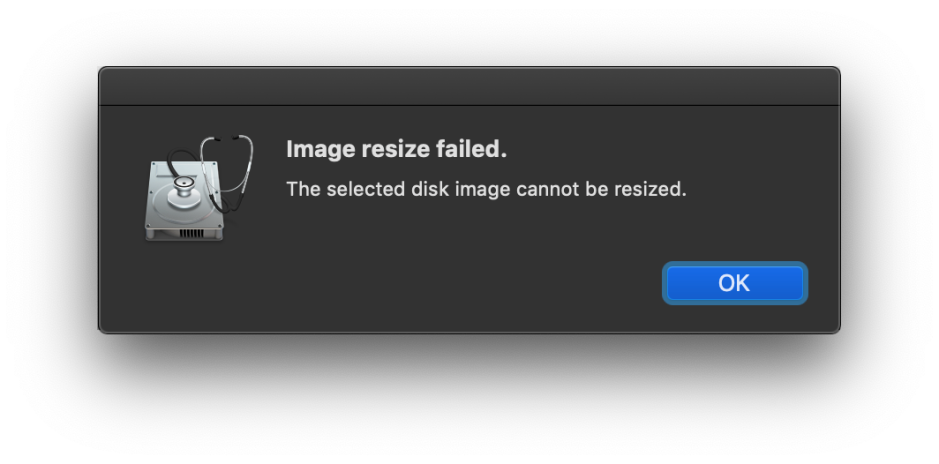
The only way to resize an APFS disk image is using hdiutil at the command line. Further details including an account of the workaround are given here.
(Thanks to Dimitris for reporting this, and to klanomath for the workaround.)
System UTIs (?WebKit) – .inetloc files can’t be opened
Prior to 10.14.3 (possibly earlier), macOS (possibly WebKit) defined a UTI of com.apple.generic-internet-location which mapped to the default browser. Apps like Firefox which save some URL bookmarks as .inetloc files of this type relied on this, so that opening one of those files opened it in Firefox.
Mojave 10.14.3 appears to remove that mapping to the default browser, so that there is no app now which is able to open an .inetloc document. This makes these bookmarks unusable, although it doesn’t appear to break any Apple software. Further details are here.
I have now confirmed that, prior to Mojave, .inetloc files were properly supported and worked. They are used here by Firefox in an effort to open bookmarks made by its reader in reader mode; Safari saves all bookmarks as .webloc files, so always opens them again in normal browser mode.
(Thanks to Christian for spotting this; details above are tentative because of complete lack of documentation from Apple.)
Finder – copy progress icons frozen
Sometimes, the circular progress icon displayed in column and list views during file copying becomes frozen. It then shows early progress at the start of copying, and remains fixed despite those files being successfully and completely copied. Presence of the icon misinforms the user that the copy hasn’t been completed when it has. These erroneous icons persistent indefinitely, until the Finder is restarted.
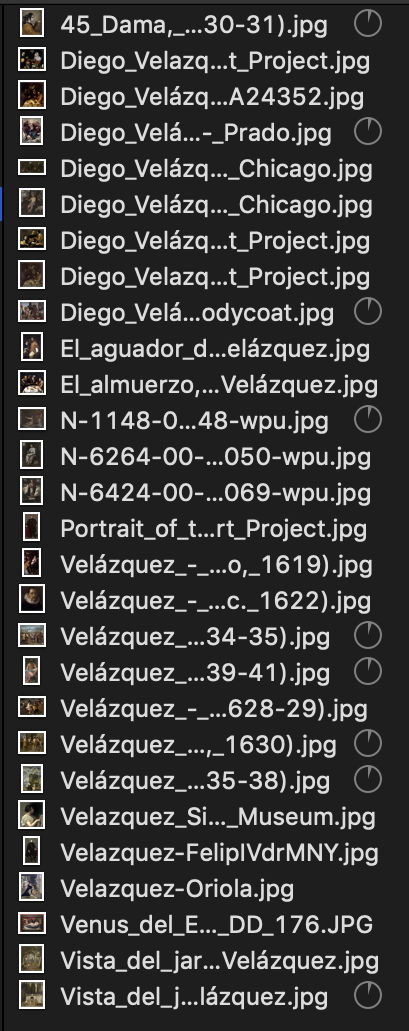
The only way to clear these is to force the Finder to restart. Further details are here.
Disk Utility – spinning beachballs after ejecting a disk image
After ejecting a disk image, Disk Utility displays a period of sluggish behaviour, during which spinning beachballs commonly appear for short periods. Another odd effect is for the app to select sequences of eject icons in rotation.
The fix for this is to select one of the remaining mounted disks or other items in the left side of the window, which should restore normal function.
(Thanks to Dimitris for reporting this.)
QuickLook – can’t handle malformed documents
When asked to provide a thumbnail or preview of some malformed documents, QuickLook hangs displaying the busy ‘spinner’ in place of the thumbnail or content of the preview.
To demonstrate this, take a copy of a text file, and replace its extension with ‘.jpg’. Select that file, and its thumbnail will be shown as the busy spinner. Press the Space bar and its preview will also be the same busy spinner. QuickLook appears unable to return an error to IconServices, or the preview window. This appears to affect mainly malformed image files, including JPEG, TIFF and PNG. It doesn’t appear to affect QuickTime movies, though, suggesting that the bug is in the qlgenerator for still image formats, which is part of macOS.
Although this doesn’t result in high CPU load, and doesn’t hang the Finder or anything else, it is a fundamental flaw which should never have appeared in release software.
Bluetooth keyboard – sporadic repetition of letters
When typing normally, even with the delay to key repeat adjusted carefully, there are occasional repetitions of letters entered via an Apple Bluetooth keyboard. This is an old problem, going back to Sierra at least, and affects multiple models (including iMac and iMac Pro). Although adjusting the threshold can reduce its frequency, the occasional letter duplication (e.g. ‘paath’ for ‘path’) still breaks through.
Keyboard pane – App Shortcuts almost unusable
Open the Keyboard pane, select the Shortcuts tab, then the App Shortcuts item at the left. If you only have the single default shortcut, add some others. After adding two or more, they will be displayed with the ellipsis character … instead of their menu title, and attempts to edit that title are frustrated because the edit area is the size of the ellipsis, not the title. There is no apparent way in which this can be corrected by the user.

There are odd inconsistencies here too: the single default item Show Help menu has a checkbox at the left, but items added by the user don’t. However, as that first item cannot be edited or removed, that checkbox is the only way to disable it.
This tab is almost unusable as a result, making it impossible to set or maintain app shortcuts.
(Thanks to John for pointing this out to me.)
Calculator – defective printing of Paper Tape
There are two obvious bugs: when running in Dark Mode, if you try printing the Paper Tape in Calculator, it remains fixed in Dark Mode, printing a rectangle of dark grey with white text. The other is that it isn’t possible to change the size of the Paper Tape; it remains stubbornly fixed even if you change the paper size to A3 in landscape mode.
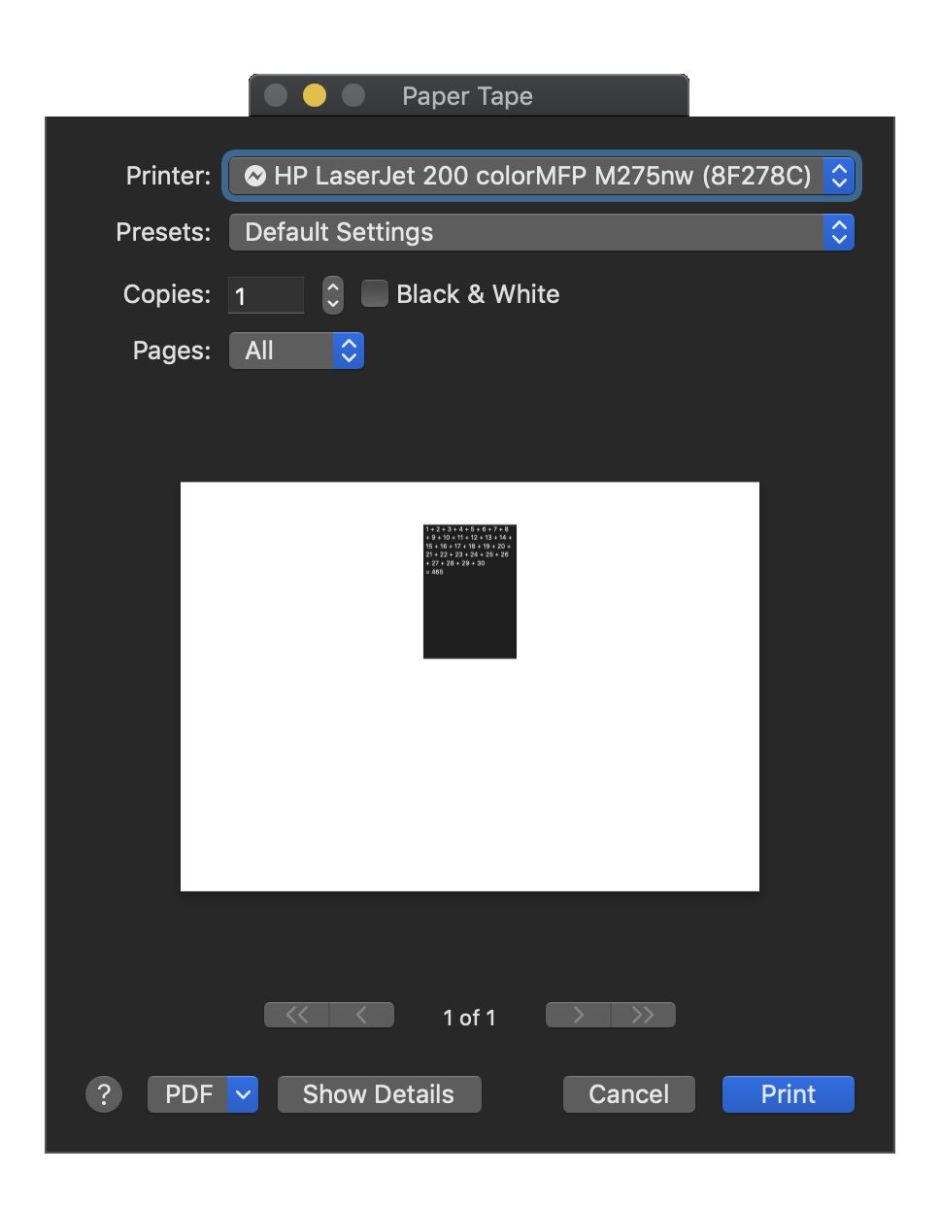
The only workaround for the first bug is to switch to Light Mode before printing; there is no workaround to the second, other than copying and pasting the Paper Tape output to another app for printing.
Activity Monitor – almost blank pages when printing in Dark Mode
Printing from Activity Monitor when in Dark Mode results in almost completely blank pages, which contain just a few icons.
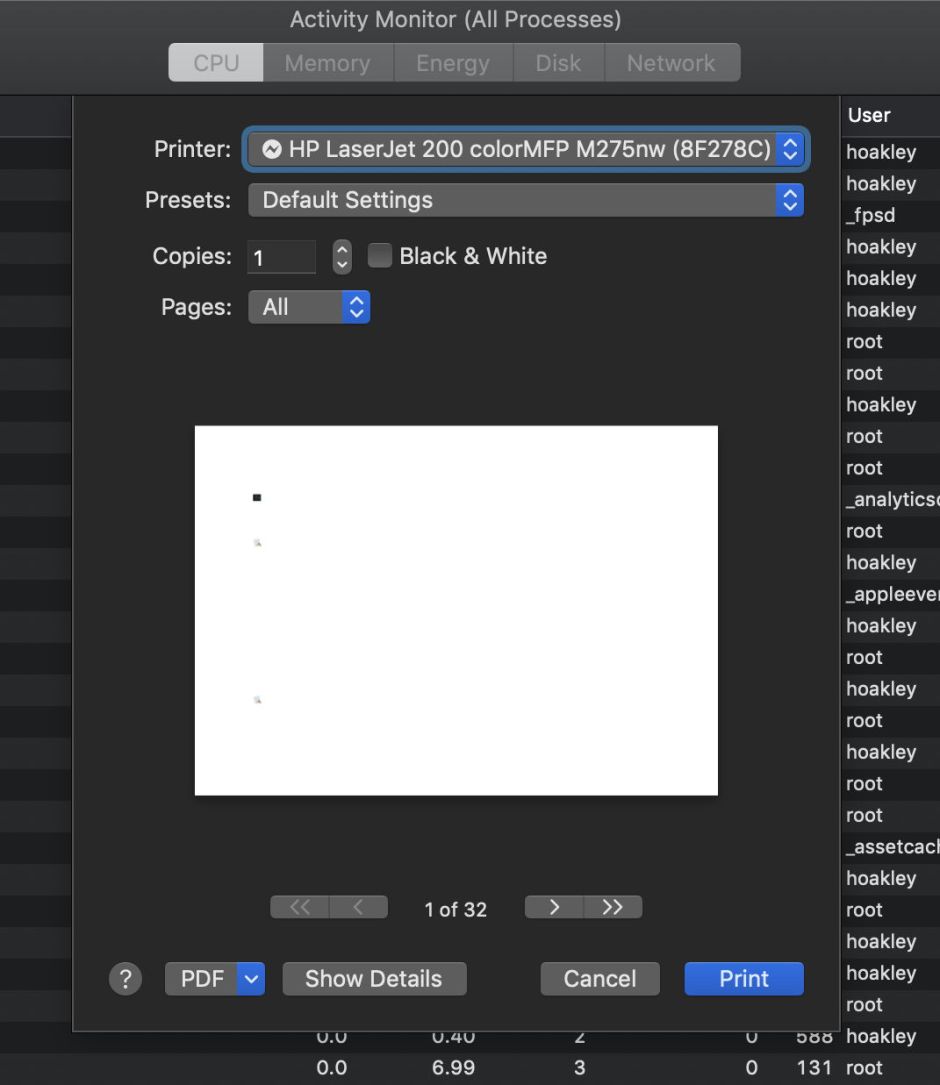
The only workaround is to switch to Light Mode to print.
Preview – selection highlighting dysfunctional
Correct app behaviour when the user changes the selection Highlight colour in the General pane, either directly or by changing Accent colour, is to change existing selections when the app window is brought to the front or otherwise updated. Preview doesn’t do this: select some text in a PDF document, for example, then change the Highlight colour in the General pane. The selected text will remain in its existing colour highlight.
In addition, the Graphite highlight colour doesn’t work at all in Dark Mode, and may not work reliably in Light Mode either.
Apps which are built on AppKit do behave correctly, though: to see how this should work, try it with, for example, my DelightEd.
(Thanks to Dimitris for explaining this to me so patiently.)
App Store – search returns weird hits
When you enter some search terms into the App Store app, completely unrelated apps appear in the results. In some cases, these are additional to genuine hits, in others they just appear weird and unrelated. For example, searching on the word consommé (a type of soup) consistently returns an app which has nothing whatsoever to do with the word, nor does it appear in the info provided about the app.

clover returns three genuine hits, and three spurious apps which are completely unrelated. This looks like the store’s metadata are corrupted with random terms.
TextEdit – colours displayed differently with Dark Background
Colours used to display text are changed when Dark Background is enabled. If you save or copy Rich Text in that display mode, the colours saved or copied are very likely to differ from those shown. To avoid this, don’t use Dark Background when you’re using colour.
This and other problems are discussed in detail here.
The version and build number of TextEdit in 10.14.3 is identical to that in 10.14.2.
Dark Mode – QuickLook and other bugs
If you use an editor such as my DelightEd which is designed to produce RTF which ‘works’ in Dark as well as Light Mode, then QuickLook thumbnails and previews switch contained text to white in Dark Mode, but retain a white background. This renders the thumbnail/preview useless in Dark Mode.
A similar problem with Dark Mode exists when you use Control-Command-D to show the definition of a selected word: the popover window is semi-transparent, which makes text in custom dictionaries visible only when viewed over a window with a white background. If the underlying window is dark grey, then that text is almost invisible.
These are described in more detail here. There don’t appear to be any workarounds for these, other than switching back to Light Mode.
Thanks to Artyom for drawing my attention to the second of these.
Safari – errors opening local Home page, and others
If you set Safari 12.0.3 to open a local file as its Home page, this may cause an error when Safari first opens, and that error may in turn result in another error reporting that the error page can’t be found. Others also report Safari’s inability to search until a remote page has been loaded, and other potentially related issues. These are detailed here (see the comments there in particular).
Once Safari has started up and connected to a remote page, these problems usually vanish, so can be safely ignored. They also appear to occur most commonly when the Develop menu is enabled; turning that off may make them disappear, but you then lose the additional features of that menu. This bug was present in 12.0 and persists in 12.0.3.(Thanks to Manoli for pointing this out.)
Font Book – can’t disable or remove fonts in /Library/Fonts
Although Font Book used to be able to, and its Help book still claims that it can, since 10.14 (including 10.14.3) it has been unable to disable or remove any font stored in /Library/Fonts. It can currently only disable or remove those in ~/Library/Fonts.
The well-known workaround is to create the folder /Library/Fonts (disabled), or similar, and move fonts to that folder to disable them.
System Migration – incompatible app list repeatedly downloaded
Periodically, for no apparent reason, Macs automatically download and re-install the incompatible app list stored in /System/Library/PrivateFrameworks/SystemMigration.framework even though it has not been updated since it was last installed. This appears as com.apple.pkg.IncompatibleAppList.[version] in the list of installations.
This is longstanding behaviour, occurring in Sierra if not before, and appears almost random.
Finder – QuickLook thumbnails too high
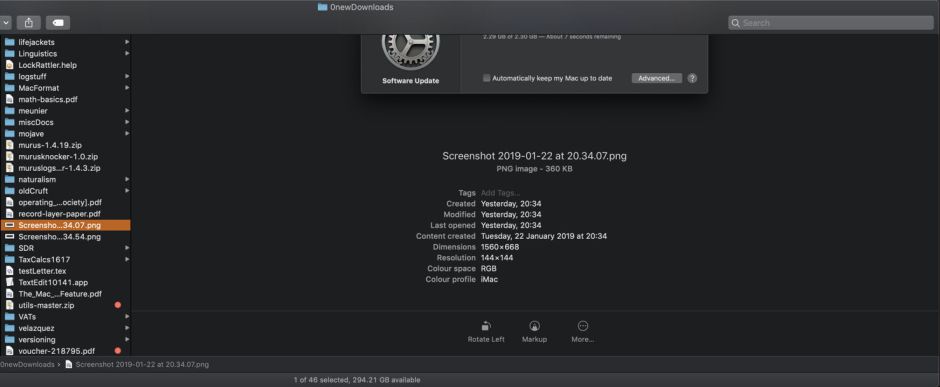
In Finder column views, the space fixed for display of thumbnails/icons is too high. This makes the user scroll to see the item’s metadata, even when the view is very deep. Further details are here. There is no workaround as far as I know, other than to scroll the view.
(Thanks to Michael Tsai for reminding to include this.)
Software Update – misleading progress indication

During the 10.14.3 update, the progress bar was misleading, only reaching just over 80% by the end of the download. There followed a significant period in which the remainder of the bar gradually filled, with no explanation as to what was going on, or estimated time to complete. Following that, the pane returned to offer Download and Install again, which finally started the update process.
There is no workaround other than patience, and further details are here.
System Preferences – General pane Accent colour confusion
Switch between non-grey and grey Accent colours repeatedly, and the colours shown in the pane quickly become confused, and show the wrong colours relative to those selected. These may also be out of sync with the colours actually set. To restore normal colours, select only non-grey colours. Full details are here.
This seems to be more deep-seated, in that the Finder can lose track of Accent and Highlight settings, and display a third colour which isn’t either of those selected. This is detailed and shown here.
(Thanks to Ryan for pointing this out.)
Appearance – grey/gray accent turns ‘traffic lights’ grey too
In the General pane, set the Accent colour to grey. Whether in Light or Dark mode, the ‘traffic lights’ at the top left of every window then show just three grey lights instead. Now which end was red?!
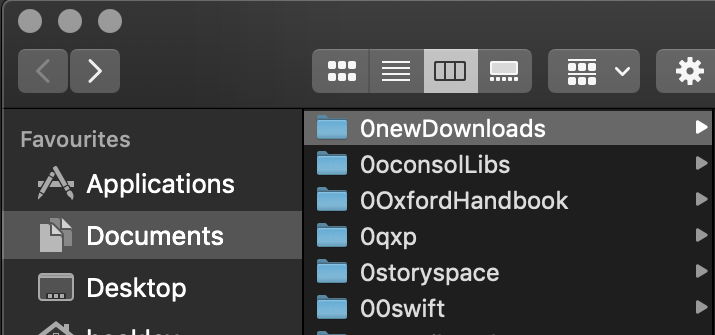
The only workaround is not to use the grey accent.
It has been argued (see comments) that this is a feature and not a bug, as it recalls the earlier grey appearance. Mojave doesn’t have grey appearance: it has Light Mode and Dark Mode as its two appearances. Within those, the colour options are ‘accents’ which change the colour of a small number of controls. Grey accent is the only accent which removes all colour from the ‘traffic lights’ and is therefore inconsistent at best. I’d call it misguided at least.
(Thanks to simweb for reporting this previously.)
Finder – incorrect column width
This can occur when using Finder windows which are set to column view. When switching folder in the view, the rightmost column being displayed has excessive width, filling the Finder window, its divider being placed incorrectly at the right edge of that window.
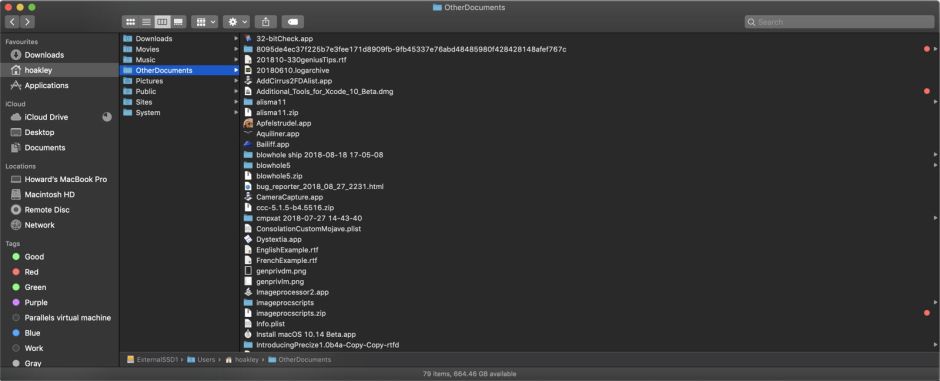
This long-standing but intermittent bug dates back to Mavericks if not earlier, and I have whinged about it here and here. It was also present in every version of El Capitan, Sierra and High Sierra. The only workaround is to select a different folder, then to select the correct folder again.
macOS – can’t get UTI type for sockets
An old bug, possibly going back to 10.5: when an app tries to discover the type of a file or folder by requesting its UTI, certain files, such as sockets ‘virtual files’, return a instead of a UTI. If this response isn’t handled by the calling app correctly, at worst the app may crash. Full details are here.
Bugs believed to have been fixed from 10.14.2
About This Mac – Storage bar now appears to report much more reliable figures, at last, although these may take time to appear.
App Store – claims apps need to be ‘redownloaded’ – doesn’t appear to occur now.
Keychain Access – pasted text shown as black on dark grey in Dark Mode – largely fixed for new notes at least.
(List closed with the release of 10.14.4, 27 March 2019.)
